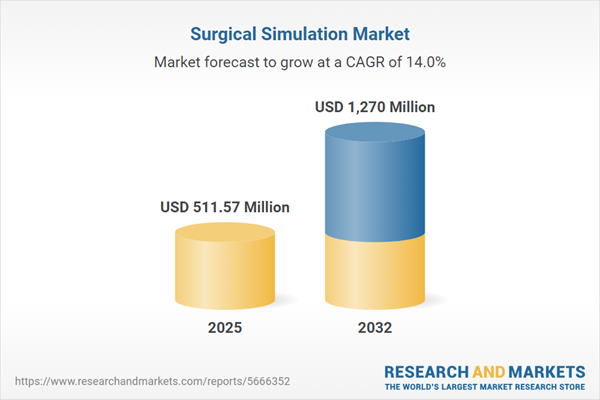Speak directly to the analyst to clarify any post sales queries you may have.
The surgical simulation market is advancing rapidly, driven by technological innovations that enable healthcare professionals to practice critical procedures and enhance patient safety. As global healthcare systems prioritize advanced training solutions, simulation emerges as a key component of modern medical education.
Market Snapshot: Growth Trajectory in the Surgical Simulation Market
The surgical simulation market grew from USD 448.62 million in 2024 to USD 511.57 million in 2025 and is projected to sustain its momentum with a compound annual growth rate (CAGR) of 13.99%, reaching USD 1.27 billion by 2032. This sustained growth reflects surging demand for high-fidelity, risk-free procedural training, coupled with increasing investment in immersive simulation platforms across leading hospitals, academic institutions, and training centers worldwide.
Scope & Segmentation: Comprehensive View of Surgical Simulation
This report offers detailed market segmentation and covers multiple aspects shaping industry dynamics:
- Product Types: Cadaveric and animal models (animal specimens, cadaveric preparations), manikin-based simulators, simulation software (assessment and curriculum platforms), task trainers, and virtual reality simulators (head-mounted and screen-based devices).
- Fidelity Levels: High-fidelity systems for advanced procedural training, medium-fidelity solutions for core skill-building, and low-fidelity options emphasizing scalability and accessibility.
- Clinical Applications: Cardiovascular, endoscopic, laparoscopic, neurosurgical, open, and orthopedic surgery simulations tailored to various technical demands.
- End Users: Academic and research institutes, ambulatory surgical centers, hospitals, and military and defense settings, each with unique training requirements.
- Enabling Technologies: Augmented reality, mixed reality, haptic feedback systems, and virtual reality solutions enhancing realism and engagement.
- Training Types: Patient safety-focused instruction, interdisciplinary team-based simulations, and technical skills training modules.
- Regional Coverage: Americas (North America, Latin America), Europe Middle East & Africa (inclusive of major and emerging economies), and Asia-Pacific, reflecting distinct adoption patterns, investment strategies, and regulatory landscapes.
Within these segments, stakeholders benefit from insight into procurement trends, infrastructure development, and curriculum integration strategies relevant to both established and emerging markets.
Key Takeaways: Strategic Insights for Senior Decision-Makers
- Widespread adoption of immersive technologies such as virtual and mixed reality is transforming surgical training environments, enabling repeated skills practice without patient risk.
- Regulatory counsels and accreditation bodies are incorporating validated simulation scenarios into credentialing and continuing education, accelerating standards uniformity and best practice adoption.
- Cloud-based platforms and remote access tools are extending expertise to geographically dispersed or resource-constrained regions, increasing training scope and reach.
- Integrated ecosystems combining hardware, software, and analytics are becoming industry benchmarks, with leading organizations forging strategic partnerships to deliver comprehensive training solutions.
- Diversified procurement models and modular technology deployments are reducing adoption barriers for smaller healthcare providers, supporting a wider market base.
- Shifts to team-based learning and real-time performance analytics are fostering decision-making and communication skills in simulated, high-pressure environments.
Tariff Impact: Navigating Supply Chain Complexity
Recent United States tariffs enacted in 2025 have increased costs for critical simulation hardware and components, prompting industry players to localize assembly operations and forge new supply partnerships. These measures have enhanced supply chain resilience but necessitated price adjustments, driving a shift toward subscription-based models and flexible financing options for end users.
Methodology & Data Sources
This analysis draws on primary interviews with simulation developers, clinical educators, and healthcare procurement specialists, supported by comprehensive reviews of secondary data from industry publications, regulatory documents, and corporate disclosures. Findings are validated through cross-referencing and subject matter expert panel review, ensuring a robust and credible research foundation.
Surgical Simulation Market: Why This Report Matters
- Senior decision-makers gain actionable insights into technological, regulatory, and educational drivers shaping market growth and competitive positioning.
- In-depth segmentation analysis allows for targeted investment across product types, applications, regions, and user categories.
- Strategic recommendations help streamline procurement processes, foster innovation, and ensure uninterrupted access to advanced training resources amid policy and supply chain changes.
Conclusion
Surgical simulation stands central to the evolution of medical education and healthcare delivery. This report gives senior leaders a clear view of industry shifts, enabling informed planning and sustained innovation in a fast-evolving environment.
Additional Product Information:
- Purchase of this report includes 1 year online access with quarterly updates.
- This report can be updated on request. Please contact our Customer Experience team using the Ask a Question widget on our website.
Table of Contents
3. Executive Summary
4. Market Overview
7. Cumulative Impact of Artificial Intelligence 2025
Companies Mentioned
The companies profiled in this Surgical Simulation market report include:- 3D Systems, Inc.
- CAE Inc.
- Laerdal Medical AS
- Surgical Science Sweden AB
- VirtaMed AG
- Mentice AB
- FundamentalVR Ltd.
- Simulab Corporation
- VRmagic GmbH
- Medical Realities Ltd.
Table Information
| Report Attribute | Details |
|---|---|
| No. of Pages | 197 |
| Published | November 2025 |
| Forecast Period | 2025 - 2032 |
| Estimated Market Value ( USD | $ 511.57 Million |
| Forecasted Market Value ( USD | $ 1270 Million |
| Compound Annual Growth Rate | 13.9% |
| Regions Covered | Global |
| No. of Companies Mentioned | 11 |









